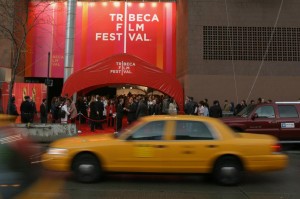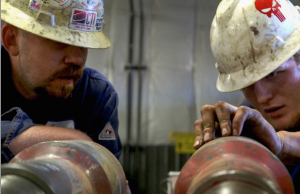What does it take to showcase workplace issues in a festival documentary? While at the Tribeca Film Festival, which showcases an eclectic variety of documentary styles and subjects and has been heralded as a better spot for docs than fiction, I spent some time trying to figure out how work is represented.
does it take to showcase workplace issues in a festival documentary? While at the Tribeca Film Festival, which showcases an eclectic variety of documentary styles and subjects and has been heralded as a better spot for docs than fiction, I spent some time trying to figure out how work is represented.
Work is of course what we escape from at the movies. But frankly, documentaries are full of what we escape from, including genocide, sex trafficking, and the violence of poverty. So please don’t use that excuse to tell me why it’s so hard to talk about or curate the conditions of work in a documentary.
And it is hard, involving (like much of documentary’s challenge) making the invisibilized visible. I assume that’s why Andrew Garrison, who is deeply interested in the conditions of work, in the festival hit “Trash Dance,” featured the work of garbage collectors through the eyes of a choreographer who worked with their union to make a work of art with them.
But there’s plenty of drama and conflict in the unglamorous workplace. Witness, to name a few, a little film from Kartemquin Films, “Taylor Chain II,” a rare at-the-table look at union negotiations; Barbara Kopple’s documentaries such as Harlan County, USA and “American Dream;” Almudena Carrecedo’s “Made in L.A.“;Julia Reichert and Steve Bognar’s recently Oscar-nominated “The Last Truck: Closing of a GM Workplace.” Look at the wealth of great workplace series on TV; my personal faves include “Enlightened” and “Dead like Me,” but we all have our preferences.
 At Tribeca this year, working-class work was as usual and pretty much everywhere hard to find. An exception was Jesse Moss’ The Overnighters, which debuted at Sundance. It follows the terms of work both for roustabouts in North Dakota’s oil industry and for a local pastor trying to do charity at home (precipitating catastrophic personal consequences) in the small town assaulted by boom times. Along with tracking the pastor’s sometimes horrifying personal journey, it also portrays a brutal working culture in which the least well-favored are the most unprotected. Most remarkable is its biggest absence, like a missing front tooth: nobody in the film ever raises the question of corporate responsibility or contribution to address a community-wide crisis. Dan Sickles and Antonio Santini’s “Mala Mala,” which follows the struggle of transgender Puerto Ricans to organize, in the process captures (in ways that some might feel borders on the exploitative) the tough lives of transgendered people doing sex work on the streets.
At Tribeca this year, working-class work was as usual and pretty much everywhere hard to find. An exception was Jesse Moss’ The Overnighters, which debuted at Sundance. It follows the terms of work both for roustabouts in North Dakota’s oil industry and for a local pastor trying to do charity at home (precipitating catastrophic personal consequences) in the small town assaulted by boom times. Along with tracking the pastor’s sometimes horrifying personal journey, it also portrays a brutal working culture in which the least well-favored are the most unprotected. Most remarkable is its biggest absence, like a missing front tooth: nobody in the film ever raises the question of corporate responsibility or contribution to address a community-wide crisis. Dan Sickles and Antonio Santini’s “Mala Mala,” which follows the struggle of transgender Puerto Ricans to organize, in the process captures (in ways that some might feel borders on the exploitative) the tough lives of transgendered people doing sex work on the streets.
 Of course, if you want to move away from what some might call the working class, or the working poor, or just the poor, it gets easier to see (and presumably sell) work to an upscale documentary-viewing audience. At Tribeca this year, you could watch high-fashion designers at work in “Dior and I,” and ballet dancers in “Ballet 422.” Both films, of course, focused on the bosses, but the work process got into the mix in both. You could peek over the shoulder of Lego designers living their dream job in Daniel Junge and Kief Davidson “Beyond the Brick: A LEGO Brickumentary.” In a relentlessly sunny, happy workplace, workers brainstorm with fans to find the Next Big Thing in Legos. Crowdsourcing, it turns out, is good for business; we all really work for Lego, though only they get paid.
Of course, if you want to move away from what some might call the working class, or the working poor, or just the poor, it gets easier to see (and presumably sell) work to an upscale documentary-viewing audience. At Tribeca this year, you could watch high-fashion designers at work in “Dior and I,” and ballet dancers in “Ballet 422.” Both films, of course, focused on the bosses, but the work process got into the mix in both. You could peek over the shoulder of Lego designers living their dream job in Daniel Junge and Kief Davidson “Beyond the Brick: A LEGO Brickumentary.” In a relentlessly sunny, happy workplace, workers brainstorm with fans to find the Next Big Thing in Legos. Crowdsourcing, it turns out, is good for business; we all really work for Lego, though only they get paid.
 If it’s exotic, that’s also a plus for catching a glimpse of people at work. At Tribeca you could watch the heart-stopping and magnificent “Virunga,” by Orlando von Einsiedel, and get inside the working process of running a park to protect gorillas and the environment, in the middle of armed conflict. You could watch street performers in India trying to make a living in a slum about to be bulldozed in “Tomorrow We Disappear,” which lacked much structure but had many charming and thought-provoking moments. The past is safe; the rise of the founder of Famous Nathan’s, told by his grandson Lloyd Handwerker in “Famous Nathan,” is a heartwarming bootstrapping story that leads from worker to owner. And I suppose art forgery constitutes work; Sam Cullman and Jennifer Grausman’s “Art and Craft” engagingly deconstructs the mystery of why a lifelong forger did what he did.
If it’s exotic, that’s also a plus for catching a glimpse of people at work. At Tribeca you could watch the heart-stopping and magnificent “Virunga,” by Orlando von Einsiedel, and get inside the working process of running a park to protect gorillas and the environment, in the middle of armed conflict. You could watch street performers in India trying to make a living in a slum about to be bulldozed in “Tomorrow We Disappear,” which lacked much structure but had many charming and thought-provoking moments. The past is safe; the rise of the founder of Famous Nathan’s, told by his grandson Lloyd Handwerker in “Famous Nathan,” is a heartwarming bootstrapping story that leads from worker to owner. And I suppose art forgery constitutes work; Sam Cullman and Jennifer Grausman’s “Art and Craft” engagingly deconstructs the mystery of why a lifelong forger did what he did.
It’s good to get a glimpse of ways to work we’ve never thought about, and couldn’t have imagined, on our way to addressing other things. But these many approaches are many ways to walk around one of the most pervasive, biggest, complex, diverse, and important phenomena of our time—the conditions of work, why and how people accept them, and what happens when they challenge or change them.
If we’re going to have more and more open conversations about documentary, then I think one about how to make and show and talk about working is one worth having, especially now. This is the season that a French economist, Thomas Piketty, became a headline for his book describing the way inequality is structural. It’s the season that Princeton and Northwestern scholars released a study showing that the will of the people has been defied in the U.S. for 35 years by, effectively, an oligarchy. Work deserves good storytellers, and they deserve good conversations about their work.
